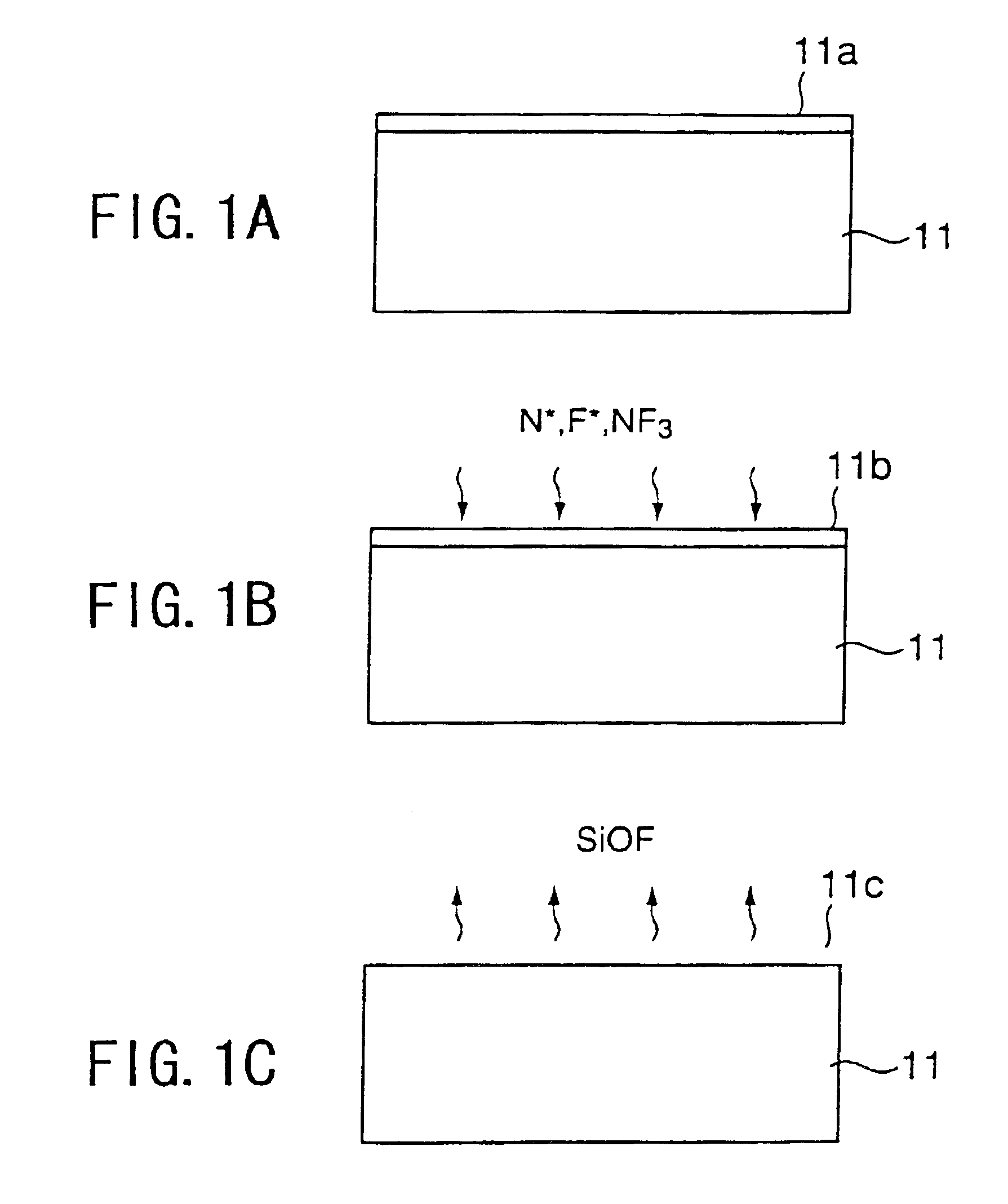Method of forming a dielectric film
- Summary
- Abstract
- Description
- Claims
- Application Information
AI Technical Summary
Benefits of technology
Problems solved by technology
Method used
Image
Examples
first embodiment
[First Embodiment]
FIGS. 1A-1H show the process of forming a Ta2O5 film according to a first embodiment of the present invention.
Referring to FIG. 1A, a Si substrate 11 is held in a reaction vessel (not shown) under a reduced pressure environment of 133-399 Pa (1-3 Torr) at a temperature lower than a room temperature, and an oxide film 11a on the surface of the substrate 11 is removed by supplying nitrogen radicals N* and hydrogen radicals H* formed as a result of plasma activation of a gas mixture of N2 and H2 into the reaction vessel together with a NF3 gas. By conducting such a removal of the oxide film at low temperature, there is formed a protective film 11b having a composition of N—O—Si—H on the surface of the Si substrate 11. In a typical example, the H2 gas, the NF3 gas and the N2 gas are supplied with respective flow rates of 10 sccm, 30 sccm and 100 sccm, and the activation of the H2 gas and the N2 gas is achieved by applying a plasma power of about 50 W. The process of FI...
second embodiment
[Second Embodiment]
FIG. 7 shows the process of forming a dielectric film according to a second embodiment of the present invention in the form of flowchart.
Referring to FIG. 7, the gaseous molecules of SiCl4 are adsorbed on the SiO2 molecular layer 12a represented in FIG. 1D in the step S1, and the SiCl4 molecules thus adsorbed are subjected to an oxidation or hydrolysis reaction in the step S2. As a result, there is formed a molecular layer of SiO2 on the substrate 11.
The foregoing steps S1 and S2 are repeated alternately a predetermined times X in the next step S3, and the process proceeds further to the step S4 corresponding to the process steps of FIGS. 1E and 1F in which the molecules of ZrCl4 or Zr(t-OC4H9)4 are adsorbed on the SiO2 molecular layer formed in the previous steps S1 and S2.
The gaseous molecular compound of Zr thus adsorbed are then subjected to an oxidation or hydrolysis reaction in the next step S5 corresponding to the process step of FIG. 1G, and there is forme...
third embodiment
[Third Embodiment]
FIG. 9 shows the structure of a dielectric film according to a third embodiment of the present invention, wherein those parts corresponding to the parts described previously are designated by the same reference numerals and the description thereof will be omitted.
Referring to FIG. 9, the present embodiment carries out adsorption of SiCl4 molecules on the SiO2 molecular layer 12a and the SiCl4 molecules are converted to a molecular layer 12d of SiN by processing the adsorbed SiCl4 molecules by an NH3 gas. After the formation of the SiN molecular layer 12d, the Ta(OC2H5)5 molecules are adsorbed on the layer 12d, and are converted to the Ta2O5 molecular layer 12c as a result of oxidation. Further, the CVD-Ta2O5 layer 13 is formed on the Ta2O5 molecular layer 12c.
In the structure of FIG. 9, it is possible to eliminate the problem of diffusion of B into the Si substrate by the SiN molecular layer 12d when a B-doped polysilicon film is deposited on the Ta2O5 film 13. It...
PUM
| Property | Measurement | Unit |
|---|---|---|
| Dielectric polarization enthalpy | aaaaa | aaaaa |
| Concentration | aaaaa | aaaaa |
Abstract
Description
Claims
Application Information
 Login to View More
Login to View More - R&D
- Intellectual Property
- Life Sciences
- Materials
- Tech Scout
- Unparalleled Data Quality
- Higher Quality Content
- 60% Fewer Hallucinations
Browse by: Latest US Patents, China's latest patents, Technical Efficacy Thesaurus, Application Domain, Technology Topic, Popular Technical Reports.
© 2025 PatSnap. All rights reserved.Legal|Privacy policy|Modern Slavery Act Transparency Statement|Sitemap|About US| Contact US: help@patsnap.com



